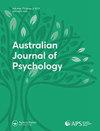Self-reported outcome measures for adults with post-traumatic stress disorder: towards recommendations for clinical practice
IF 3.6
4区 心理学
Q1 PSYCHOLOGY, MULTIDISCIPLINARY
引用次数: 1
Abstract
ABSTRACT Background The 2018 Phoenix Australia Clinical Practice Guidelines for Post-traumatic Stress Disorder (PTSD) recommended that practitioners use validated, user-friendly self-report measures for PTSD in their practice. However, selecting which measure to use can be difficult as there are currently no guidelines for selection. This research sought to evaluate self-report outcome measures for adults with PTSD and produce recommendations to guide clinicians. Method A systematic search was use qd to identify relevant articles and a comprehensive list of the existing measures of PTSD symptoms were extracted. A second search for validation papers for these measures was then conducted. Using these validation papers, measures were evaluated for their psychometric properties and utility for clinical practice via a purpose-built evaluation tool. Findings Twenty-two self-report outcome measures for PTSD were extracted from 256 randomised controlled trials. For these measures, 110 validation papers were located. For nonspecific trauma exposure populations, the PCL-5 and SPRINT were found to be the most psychometrically valid measures, with the highest scoring clinical utility. The measures for 12 specific trauma exposure populations were examined and discussed. Conclusion This paper has direct clinical relevance for working with individuals with PTSD and provides researchers and clinicians with justification for outcome measure selection. KEY POINTS What is already known about this topic: It is recommended that clinicians use validated, user-friendly self-report measures to support their assessments of treatment outcomes over time for post-traumatic stress disorder (PTSD). Clinicians may struggle to select which measure to use in their practice when faced with a plethora of choice regarding outcome measures for PTSD, especially given the impact of the DSM-5 update. The differences between measures which are utilised frequently (i.e. ‘common’ measures) and measures with good psychometric properties (i.e. validated measures) and those with good clinical utility (i.e. usability) can be difficult to understand What this topic adds: This paper used systematic review methodology was used to identify & evaluate a comprehensive list of self-report outcome measures for PTSD since the DSM-5 update in 2013 and the populations that they should be used with. For non-specific trauma exposure populations, the PCL-5 and SPRINT were found to be the most psychometrically valid measures, with the highest scoring clinical utility. The most psychometrically valid measures, with the highest scoring clinical utility for twelve specific trauma exposure populations are also presented.成人创伤后应激障碍的自我报告结果测量:对临床实践的建议
背景2018年澳大利亚凤凰城创伤后应激障碍(PTSD)临床实践指南建议从业人员在实践中使用经过验证的、用户友好的PTSD自我报告措施。然而,选择使用哪一种测量方法是困难的,因为目前还没有选择的指导方针。本研究旨在评估成人PTSD患者的自我报告结果测量方法,并提出指导临床医生的建议。方法采用qd系统检索相关文献,提取现有PTSD症状测量指标的综合列表。然后对这些措施的验证文件进行了第二次搜索。使用这些验证文件,通过专门构建的评估工具评估测量方法的心理测量特性和临床实践效用。结果从256项随机对照试验中提取了22项PTSD自我报告结局指标。针对这些措施,找到了110份验证文件。对于非特异性创伤暴露人群,PCL-5和SPRINT被发现是最有效的心理测量方法,具有最高的临床效用得分。对12个特定创伤暴露人群的措施进行了检查和讨论。结论本研究对PTSD患者具有直接的临床意义,为研究人员和临床医生选择结局测量指标提供了依据。关于该主题的已知内容:建议临床医生使用经过验证的、用户友好的自我报告方法来支持他们对创伤后应激障碍(PTSD)治疗结果的评估。临床医生在面对过多关于PTSD结果测量的选择时,特别是考虑到DSM-5更新的影响,可能很难选择在实践中使用哪种测量方法。经常使用的测量方法(即“普通”测量方法)和具有良好心理测量特性的测量方法(即经过验证的测量方法)以及具有良好临床实用性(即可用性)的测量方法之间的差异可能很难理解。本主题补充:本文使用系统评价方法来识别和评估自2013年DSM-5更新以来PTSD自我报告结果测量的综合列表及其应该使用的人群。对于非特异性创伤暴露人群,PCL-5和SPRINT被发现是最有效的心理测量方法,具有最高的临床效用得分。最心理测量有效的措施,与最高得分的临床效用十二个特定的创伤暴露人群也提出。
本文章由计算机程序翻译,如有差异,请以英文原文为准。
求助全文
约1分钟内获得全文
求助全文
来源期刊

Australian Journal of Psychology
PSYCHOLOGY, MULTIDISCIPLINARY-
CiteScore
5.50
自引率
0.00%
发文量
19
期刊介绍:
Australian Journal of Psychology is the premier scientific journal of the Australian Psychological Society. It covers the entire spectrum of psychological research and receives articles on all topics within the broad scope of the discipline. The journal publishes high quality peer-reviewed articles with reviewers and associate editors providing detailed assistance to authors to reach publication. The journal publishes reports of experimental and survey studies, including reports of qualitative investigations, on pure and applied topics in the field of psychology. Articles on clinical psychology or on the professional concerns of applied psychology should be submitted to our sister journals, Australian Psychologist or Clinical Psychologist. The journal publishes occasional reviews of specific topics, theoretical pieces and commentaries on methodological issues. There are also solicited book reviews and comments Annual special issues devoted to a single topic, and guest edited by a specialist editor, are published. The journal regards itself as international in vision and will accept submissions from psychologists in all countries.
 求助内容:
求助内容: 应助结果提醒方式:
应助结果提醒方式:


